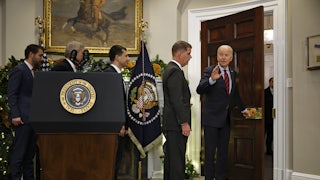Grace Norris was hopeful when she logged into her first virtual bargaining session with Starbucks on the morning of October 24. A few months after she started working at a store in Lansing, Michigan, she and her co-workers decided to follow the lead of workers in Buffalo, New York, and launch their own union campaign. Despite opposition tactics from the company, including legal maneuvers that delayed the election by months, her store voted to unionize in June.
Now it was time to take the next step: negotiate with the company over working conditions, the whole reason for unionizing. Starbucks workers are demanding better staffing in stores, zero tolerance for harassment, an increase in health and safety measures, just-cause firing rights, and a labor-management committee to oversee store working conditions, among other measures. Norris and her fellow organizers knew it was possible Starbucks would object to the hybrid format of workers joining the bargaining session virtually and in person, but “maybe if we held strong and started reading the proposals they would be inclined to just sit there and listen,” she said.
At 9 a.m. sharp, though, Starbucks’s lawyers walked into the room and then immediately left, claiming they had to caucus and discuss in private. They never came back. Instead, they spent the entire six-hour session talking among themselves—about what, they refused to say, although the company has objected to the hybrid format. (Starbucks didn’t respond to a request for comment.)
Norris attended sessions in person on October 26 and 27, only to watch the exact same process play out. Organizers got as creative as they could, reading their proposals the instant the Starbucks team entered the room until the door shut. They’d time how long they could keep them in the room—even three minutes felt like a success. On the last day, Norris’s team tried to at least get the company’s lawyers to take the proposals with them as they left, but they refused. “You could pretend, just go and throw this in the trash,” she said. “You could at least pretend you were interested in bargaining with us, but they’re not.”
“They are getting paid to sit there and waste our time,” she added. “Meanwhile, we’ve had to take time off work to come to these tables.”
Over 250 Starbucks stores have unionized since late 2021. It takes immense courage, resources, and strategic thinking to pull that off. And yet it is only the beginning. None of those stores has a contract, which means these unionized workers have virtually no say in their workplaces yet. Starbucks has refused to sit down and bargain with them over the potential improvements that motivated them to unionize in the first place.
There has been a veritable wave of unionizing at retail- and service-sector workplaces this year, including Amazon, Apple, Chipotle, REI, and Trader Joe’s. None of them has a contract. Starbucks isn’t the only company that’s stalling. Despite employees at the JFK8 Amazon warehouse voting in April to join the Amazon Labor Union, or ALU, they have yet to sit down with the company; instead, Amazon has fought for months to overturn the result.
These workers are quickly learning a terrible truth of organized labor: Forming a union is just a first step along a path that can wind on and on for years.
That realization could keep more workers from joining the wave. “It feeds back on itself,” warned Sharon Block, executive director of the Labor and Worklife Program at Harvard Law School. “There’s just only so much you can ask from people who are scrambling and struggling to pay the bills, to keep working this hard for a system that doesn’t work for them.”
Unionizing is no easy feat. A third of employers fire workers trying to unionize, about half threaten to cut wages and benefits, and 57 percent threaten to shut down plants. They are charged with violating labor law in over 40 percent of union drive campaigns.
But as difficult as it is to brave such intimidation and successfully get through an election, that’s just one part of the process. “The impediments and the obstacles to getting to an agreement are actually even more difficult to overcome,” Block said. About half of unions will have no contract a year after winning their elections, and 30 percent will still be fighting three years later.
The most powerful tool employers have is to delay, and there are plenty of ways they can do it. As in the case of Amazon, they can turn around and challenge the outcome of a successful election and continue appealing any decisions in favor of the union.
If the union clears that hurdle, an employer is supposed to begin bargaining, but companies concoct any number of reasons to refuse. Starbucks workers have filed an unfair labor practice charge with the National Labor Relations Board over the company’s objection to hybrid sessions, claiming it’s violating labor law by not bargaining in good faith. That, too, is a slow process—the charge will have to be investigated by the NLRB general counsel and then adjudicated by the board. Even then, the company can appeal all the way up to the Supreme Court. If the union prevails, the only penalty levied on Starbucks would be a requirement to sit down and bargain. It would face no fines for breaking the law. Employers “have absolutely nothing to lose except attorneys’ fees if [they] take every opportunity to delay sitting down at that bargaining table,” Block said. Meanwhile the employer gains years of not having to grant any of the union’s demands.
In the intervening time, the union itself has to be “in a perpetual organizing mode,” Block said, keeping up enthusiasm so that members are ready to put pressure on the company whenever bargaining commences. Energy can easily fizzle as workers wonder whether it was worth it to stick their necks out for a union that hasn’t secured anything for them. At the same time, the unions that are most successful in securing first contracts are generally those that have organized the majority of a company’s worksites. “It’s a catch-22, because, in order to get a contract, they have to organize more workplaces,” said Kate Bronfenbrenner, director of labor education research at the Cornell University School of Labor and Industrial Relations. The ALU has already faced this predicament: Should it focus its time and resources on unionizing more warehouses or on fighting for a first contract on Staten Island?
Things don’t necessarily get easier once an employer finally comes to the table. It technically has to bargain in good faith, but there’s some gray area as to what that entails, and there’s no requirement for reaching a final agreement. Many employers engage in “surface bargaining,” or going through the motions with no intent to sign a deal with the union. Block pointed to some “hallmarks” of surface bargaining: sending representatives who don’t have the authority to agree to anything, or agreeing to something one day and then going back on it the next. But while surface bargaining isn’t allowed, there’s no strict formula for what it entails, and it’s hard for the NLRB to crack down on it.
NLRB general counsel Jennifer Abruzzo has been exploring ways to give the agency more power in this process, including asking courts to issue injunctions forcing employers to bargain when they drag their feet. “If they’re making a mockery of the collective bargaining process,” Abruzzo told me, “we’ll go into district court and get an order requiring the employer to bargain in good faith for X period of time.” In late November, the board issued its first decision finding that Starbucks broke labor law by refusing to bargain with the union at a store in Seattle, requiring it to sit down with the workers. But the agency can’t require a company to reach an agreement. “The NLRB can force an election,” Bronfenbrenner said, “but the NLRB can’t force a contract.”
Given how hard this process is on workers and organizers, some have opted to go a different route. On November 19, the Union of Southern Service Workers launched. It’s not seeking to hold NLRB elections; instead, workers are banding together across the fast-food, retail, warehouse, and care sectors to demand higher pay, protection from harassment and discrimination, a change to firing and grievance processes, an increase in health and safety standards, paid sick leave, better scheduling, and “a seat at the table.” Over 100 workers signed membership cards at a three-day summit in South Carolina in November, where there were spontaneous eruptions of chanting, singing, and crying.
Ieisha Franceis is a perfect example of why the union wants to organize across companies and sectors. She worked as a certified nursing assistant at nursing homes for over two decades, then left at the start of the pandemic for a job in fast food. She’s now an assistant manager at a clothing store in Durham, North Carolina, earning $18.50 an hour. It’s not enough to support her, her son, and a dozen grandchildren she financially supports. “I’ve still found myself in positions of: Do I pay the light bill or do I go grocery shopping?” she said.
With high turnover in these kinds of jobs, unionizing one store takes too much time, she noted, and once people move on to a different job, they don’t benefit anymore. Instead, she and her fellow organizers are recruiting service workers in the South to participate in petitions, protests, and strikes to press for their list of demands no matter where they work. “They’re universal throughout this industry,” she said. “We’re just going to keep doing what we’ve been doing and go directly at these corporations.”
Franceis has already benefited from this model. She and her co-workers at her fast-food job wanted the company to give them hazard pay and implement a Covid safety policy when the pandemic began. So they sent management a petition, then staged a walkout at the start of the lunch rush that shut the store down for the rest of the day. It was “the scariest, most fulfilling thing I’ve ever done in my life,” she said. Afterward, the company met all of their demands, she said. “Right then is where I realized that these corporations don’t run their businesses,” she said. “Without us, there is no business. They can’t make a dime without us.”
The Union of Southern Service Workers builds off the parent campaign that helped launch it, the Fight for $15. These kinds of campaigns might notch concrete gains—12 states and Washington, D.C., have passed legislation raising their minimum wages to $15 an hour since the Fight for $15 began. But they have downsides, too. Without a contract, Bronfenbrenner said, “you can make change that way, but you don’t have the same voice and representation and control.”
With few rules and regulations on their side, unions must get creative to force employers to the table. Some workers have successfully put pressure on companies by appealing to their customers. The Coalition of Immokalee Workers, a group of agricultural workers who were able to get growers to crack down on sexual harassment, did so by targeting the fast-food chains that bought their produce. Workers at companies like Amazon and Apple could reach out to the white-collar tech workers—some employees at Amazon backed the workers when they went on strike in 2020. “Figuring out the vulnerabilities of the company and hitting them in a multifaceted, escalating campaign: That’s what it’s going to take,” Bronfenbrenner said.
As frustrated as Norris felt watching Starbucks representatives refuse to bargain, she also found it motivating. Each time Starbucks representatives walked out, workers had six hours to discuss among themselves how to increase the pressure. “It was like, ‘All right, what do we do now?’” she said.
They served up their answer in mid-November. Workers at over 100 stores went on strike in what they called the Red Cup Rebellion over Starbucks’s refusal to bargain. They picked a day with significance for the company and its most loyal customers: November 17, Red Cup Day, the one day in the year when the company gives out free, reusable holiday cups to promote its holiday drink menu.
Norris’s store participated despite the sudden arrival of near-freezing temperatures. Her job was to explain to customers why the Starbucks was closed that day. Her store is particularly high volume, and without enough employees on the schedule, lines often stretch long. The union wants fair staffing not just so workers will feel less stress but so customers will get a better experience. “This is one of the many ways the union is going to make the store better for workers and for customers,” she said. “People seemed really receptive to that.” Some who had wanted to buy coffee returned to give the striking workers cookies.
“We showed them that we’re a nationally coordinated movement and we’re taking this very seriously. All we want to do is sit down and bargain our very reasonable demands,” Norris said. “I think we made our message to Starbucks very clear, and now the ball is in their court.”






